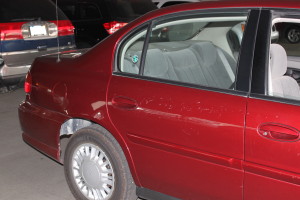It’s Not the Ride, It’s the Journey
I have never cared much about cars.
It’s an odd dichotomy. I owe so much of my comfortable middle-class life to the automotive industry, where so many of my family members spent long hours on an assembly line, and yet, I barely notice anything about cars. As Alanis Morrissette might say, “Isn’t it ironic?”
The only reason cars are on my mind (aside from the sounds of Back to the Bricks outside my windows) is that my husband and I just leased a new car because our old lease was up. If there’s one person who cares even less about cars than me, it’s my husband. So, every car buying/leasing experience for us is akin to having a tooth extraction in the 16th century. Painful, excruciating, and there is always a big hole left in our family wallet.
Luckily for me, I have a car that gets me from Point A to Point B. It’s a 2003 Chevy Malibu with nearly 75,000 miles. I have no plans to retire it any time in the near future. It proudly bears the dents and scrapes from countless students who arrive late for class and fling their car doors open, nailing the the side of my car. It use to bug me, but now I like to think of that as my contribution to student stress relief. It’s a losing battle to care about the small scratches in life.
Oddly enough, as happy as I am with my non-descript scratch mobile, I sometimes feel that people think I should drive a better/different/newer/fancier car. I usually get this feeling whenever a colleague and I have to go off campus to a meeting, and I offer to drive. Once people lay eyes on my car, my offer is usually nicely rejected with, “That’s okay. I can drive.”
I don’t honestly believe a nicer car would improve my job performance. A car has nothing to do with my ability to go from zero to sixty when I’m under the pressure of a deadline. For me, it’s one of those cliches about life–“It’s the journey, not the destination.” Or in my case, “It’s the journey, not the machine you travel in.”
Which, brings me to my point. I know…I took the long way and I should have Mapquested the route to my premise.
The point is simply this: it’s time to focus on what really matters instead of the stuff that really doesn’t. Here is what I mean:
In the pursuit of results that matter to our beloved university, I worry that people are focused on the frosting and not the cake. I constantly hear the “we need to think outside the box” when the truth is, we don’t think enough about the box. An example of this are the many departments who request a brochure or a new design for their website. In both cases, people tend to be focused on aesthetics. “Our website is so ugly!” “We need some cool new, whiz bang things for our homepage,” “I really think embossing is what’s needed on this print piece.”
Yes, I grant you that it’s good for things to look nice and be well-designed–they have to be or my department would be out of work. However, I think what is missing is the purpose behind the design.
I have seen amazingly beautiful brochures that collect dust in brochure racks because no one thought about how they should be distributed to target audiences. I have read brochures that are focused on “us” as opposed to the reader of the brochure. I have seen some really cool flash elements on a website, but then users can’t find what they need.
The point of marketing and communication is to be clear, not necessarily clever. A favorite example I have of clever marketing is the infamous Pets.com sock puppet.
Remember that cute thing? Do you recall the hilarious Super Bowl commercial? That sock puppet was everywhere and today, it is no where. Pets.com went under. The sock puppet is no more.
That’s just what I mean. Yes, on the surface, Pets.com appeared to have it all together, but it was style over substance. The things that have become lasting and stood the test of time are things that focused on what mattered to the user–can there be a more simple design than Google?
One of my mantras in life is to focus on the things that matter. I know you’re thinking (insert dripping sarcasm), “Oh wow Jen, that is so deep and original.” Well, you’re right–it’s not. But how often is that often-said phrase actually practiced? We get distracted b y the shiny objects. In focusing on the things that truly matter, we can be guided to make better, smarter decisions, especially when it comes to marketing and communication. An example of this type of thinking at UM-Flint was Undergraduate Admissions’ simply brilliant idea to have directions to popular locations on campus at all campus Information Desks. Visitors were getting lost and frustrated after hearing someone try to describe the best way to get from UCEN to University Pavilion. Of course, this seems like an obvious solution, but it is a wonderful lesson about the power of getting back to basics.
And now…Back to the Bricks…
Jen Hogan




